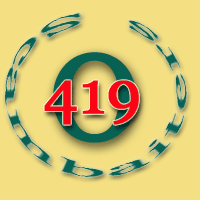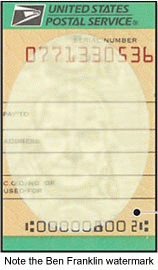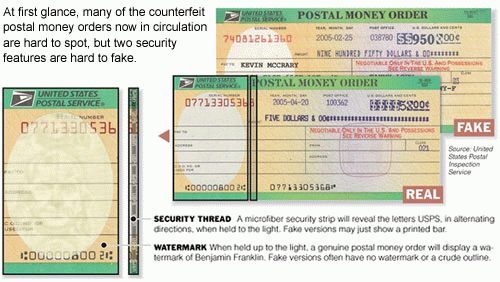
• Home •
Victim´s Story •
Fraud Prevention •
Project GSO •
Hall of Shame •
LINKS •

All About Counterfeit Money Orders
What are Counterfeit Money Orders?
Should you accept a money order as payment for goods sold online? How do you know if it's real? Identifying counterfeit money orders is easy if you know what to look for Online fraud artists have been using counterfeit and worthless checks for years. Lately there has been a surge in schemes involving sophisticated counterfeiting of a different form of payment: United States postal money orders. The quality of what these con artists are producing is very good and ordinary consumers can easily be fooled. This scam is not only found at the on-line auction sites such as eBay or Craigslist but through email solicitations also.
In the last six months, the F.B.I. and postal inspectors say, international forgers - mostly in Nigeria, but also in Ghana and Eastern Europe - appear to have turned new attention to the United States postal money order. More than 3,700 counterfeit postal money orders were intercepted from October to December, exceeding the total for the previous 12 months.
Counterfeit Money Order Arrests are on the Rise Worldwide
There have been at least 160 arrests made in the United States since October in cases where people have been suspected of knowingly receiving fraudulent postal money orders or trying to cash them. Unfortunately if you have been a victim to any of these individuals your money or you product is long gone.
Despite the arrests, however, the schemes often do not involve attempts by the fraud artists to cash the postal money orders. In many cases, unwitting victims, often contacted by an e-mail message or in an online chat room, are deceived into accepting the bogus money orders as payment for items they are selling, or into cashing the orders in return for a fee. It is the latest twist in a long series of Internet schemes that use bogus financial instruments to bilk unsuspecting victims out of merchandise and cash.
The United States Postal Service can not estimate the dollar value of the counterfeit postal money orders it has intercepted. But other sources estimate that the amount runs into the millions of dollars.
The trend is significant, because unlike private business checks or even other money orders, the postal money order is generally regarded as one of the more difficult financial documents to counterfeit because of its watermarks, security threads and a rainbow of inked patterns and tones.
Small Internet Retailers and the Public are Favorite Targets for Money Order Counterfeiters
The fake money orders have been received by small Internet retailers, classified advertisers or others lured into an Internet con scheme, from sellers of antiques to exotic and classic automobiles. Consumers are simply not using common sense during these transactions.
Postal inspectors had been working with delivery companiesto intercept packages containing bogus money orders as they entered the United States, as well as warning financial institutions to be vigilant. Tips for identifying counterfeit postal money orders are available online, at http://www.usps.com/postalinspectors/.
How to tell the difference between genuine USPS postal money orders and fake ones
U.S. Postal Service Money Orders have security features that distinguish them from other financial instruments. Learning to recognize them will protect you from being victimized by the scheme. Postal Money Orders have special inks, watermarks, and security threads. The two most prominent security features can be viewed by holding the money order in front of a light source. Look for these features: A watermark of Benjamin Franklin, the oldest and one of the most famous signers of the Declaration of Independence and the U.S. Constitution, is visible on both the front and reverse side of the money order when held to the light.
A dark security thread running (top to bottom) to the right of the Franklin watermark, with the tiny letters "USPS" facing backward and forward.
The Postal Service issues domestic and international money orders. Domestic Postal Money Orders cannot exceed a value of $1,000. They are distinguished by their green, yellow, and blue colors. Most counterfeit Postal Money Orders are domestic, with a face value of $750 to $950.
International Postal Money Orders are printed in pink, yellow, and gold and cannot exceed a value of $700. There has been an increase in counterfeit international money orders printed with values of $500 to $700
How Counterfeit Money Order Scams Work
In a typical swindle, a seller is sent counterfeit postal money orders in excess of the cost of the item being ordered. The seller is then asked to keep the cost of the purchase and ship back the balance in cash, along with the merchandise. This is also known as a Nigerian Scam because many of these types of scams have originated in Nigeria or other African nations. These scams have become very sophisticated recently and there are all kinds of variations. If you want to ensure that you aren't accepting a counterfeit money order never accept one from a stranger unless you have some way of verifying it's authenticity. You can also protect yourself by being smart and watching out for warning signs such as offers to pay more than something is worth. Paying attention to "red flags" instead of ignoring them can save you a lot of grief...and money.
Seller beware!
Be on the Lookout for Counterfeit Money Orders
A fraud scheme involving counterfeit checks and money orders is speeding across the Internet, costing financial institutions and their customers thousands of dollars.
The scam begins when scam artists hide behind the internet, posing as students abroad, someone working overseas, or stranded travelers needing help to cash a check or money order. The scam artist contacts the victim by e-mail, through an Internet chat room, or on an online auction site.
The unsuspecting victim provides a home address, to which the scam artist sends the check or money order, with a request to cash or deposit it into the victim's bank account. Victims are told to keep some of the money as a gift or payment for their help, and wire the remainder back to the scam artist.
The catch? The money orders or checks are counterfeit.
The U.S. Postal Service has incorporated security features that distinguish U.S. Postal Service Money Orders from other instruments; understanding these features will protect you from being made the victim of this type of scheme. Similar to U.S. currency, Postal Money Orders are specially designed with different-colored inks, watermarks, and security threads. U.S. Postal Inspectors advise you to protect your business and your customers, by verifying the authenticity of U.S. Postal Money Orders using the security features listed below:
- A watermark of Benjamin Franklin is visible on both the front and reverse side of the money order when held to the light.
- A 'USPS' security thread is embedded in the Postal Money Order paper.
- Red ink on the Postal Money Order serial number bleeds through to the back side of the paper.
- Paper stock should be crisp and textured.
- Warning instructions are listed on the reverse side of a genuine Postal Money Order.
- Denominations are indicated in two locations on the Postal Money Order.
- Denominations should be no larger than $1,000.
- There should be no discoloration around the denomination amount. If there is, this indicates that the original amount has been erased and a new one inserted.
If you cannot verify all of theses security features, do not accept the Postal Money Order.
Although the cash value of counterfeit money orders varies, most of the phony notes identified by the Postal Service range between $750 to $950 - just below the $1,000 maximum. It is common for a victim of this scam to present a number of money orders at the same time, or the victim may say he or she is cashing Postal Money Orders for a 'friend' overseas.
Please remember to check the authenticity of Postal Money Orders and help stop this scam!
Notify your local police department of instances of fraudulent Postal Money Orders discovered. Local police are requested to coordinate and share investigations of counterfeit U.S. Postal Money Orders with Interpol USNCB.
INTERPOL
General Secretariat
200, quai Charles de Gaulle
69006 Lyon
France
Fax: (33) 4 72 44 71 63
http://www.interpol.com/Public/contact.asp
Counterfeit currency
Introduction
A major challenge confronting societies today is the growing integration of the world’s economies, which has sparked myriad transnational criminal schemes designed to exploit financial payment systems. Fraud schemes involving credit cards, identity theft, bank fraud or the most fundamental financial crime – the production of counterfeit currency – recognise no national boundaries.
Although counterfeiting has diminished substantially since the establishment of special law enforcement units assigned to fight it, the crime continues to present a potential danger to national economies and financial losses to consumers. Recent developments in photographic and computer technology, as well as printing devices, have made the production of counterfeit money relatively easy, thereby increasing the threat.
The protection of currencies from counterfeiters is increasingly dependent on partnerships between law enforcement agencies, financial institutions and other expert organizations. These partnerships bridge geographic, jurisdictional, cultural and organizational divisions, which were once impediments toward providing comprehensive and co-ordinated solutions for combating modern financial crimes.
Through Interpol’s network of 186 member countries, communication via the I-24/7 global police communications system and the efforts of the Counterfeit and Security Documents Branch (CSDB), the General Secretariat will continue to assist in strengthening these partnerships.
Cooperation
Many counterfeit issues concerning our member counties have been addressed through training classes, working group meetings and conferences, as well as intelligence-sharing through our vast communication network.
Interpol, through its Counterfeits and Security Documents Branch (CSDB), recognizes and believes that cooperation between law enforcement, central banks, and private industry are paramount in order to fully address counterfeit currency. The CSDB philosophy is that through partnerships, we can better serve the needs of the community and reduce duplicity of effort, while combating this particular crime.
Therefore, CSDB has fostered relationships with entities such as the United States Secret Service (USSS) and Europol; as well the European Anti-Fraud Office (OLAF), European Central Bank (ECB), and the Central Bank Counterfeit Deterrence Group (CBCDG); and with innovative leaders in private industry.
Recent events
The General Secretariat remains committed to developing services which better serve the international community in order to address the problem of currency counterfeiting. Through our relationships with law enforcement, banking and industry organizations, we will continue to provide added value to reduce the threat of counterfeiting.
Interpol’s participation in meetings to address currency counterfeiting
Update on List of Currencies
An updated version of the List of Currencies is available on this website. This page lists the currencies of all 186 Interpol member countries and provides links to individual central banks’ websites.Additional information
To obtain more information or to inquire about our anti-counterfeiting initiatives, please contact Interpol.
For more information on the euro and its characteristics, please visit the European Central Bank (ECB) or Europol websites.
For additional information on the US dollar and its characteristics, please visit the U.S. Bureau of Engraving and Printing website.
For specific information about the Central Bank Counterfeit Deterrence Group (CBCDG), please visit their website: www.rulesforuse.org.
© 2006-2011 by GSO • Contact

